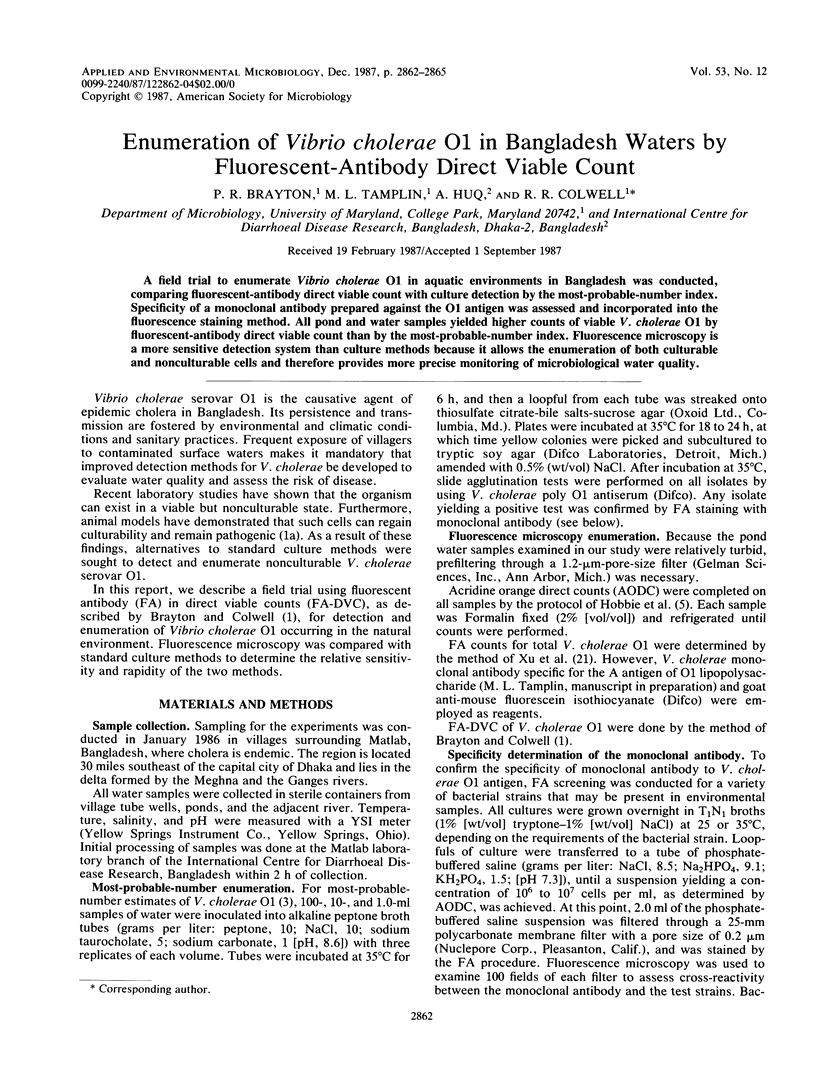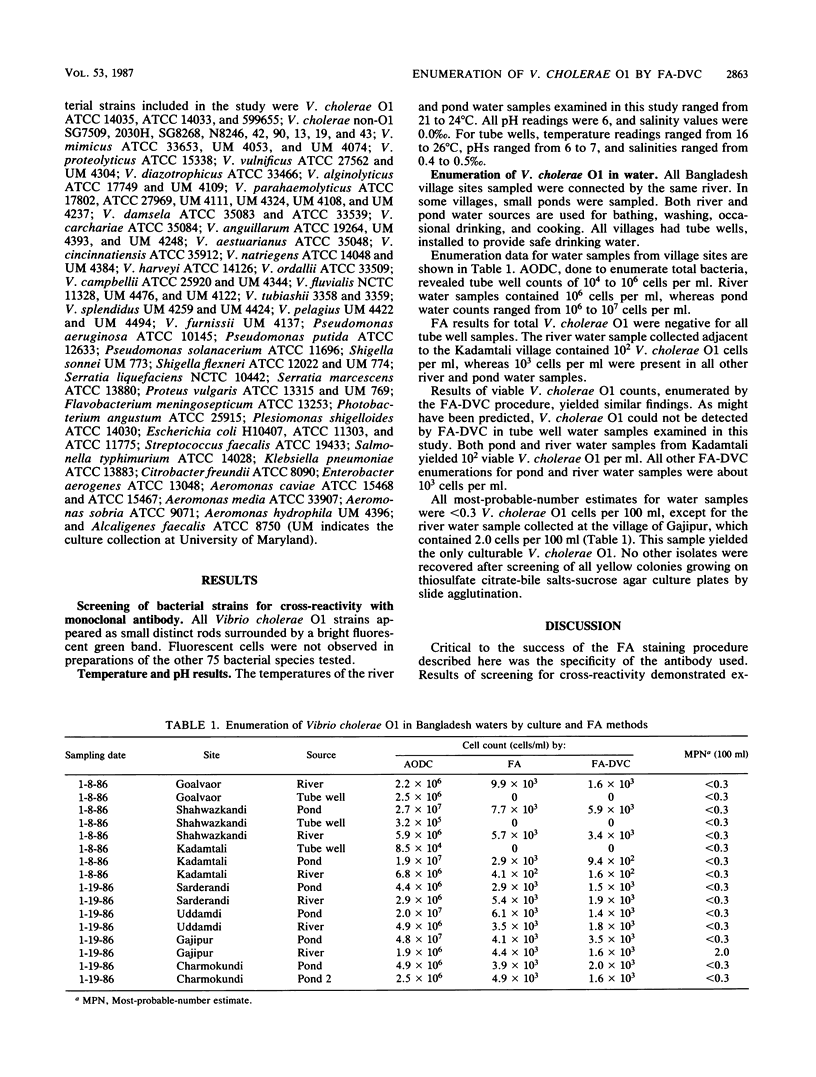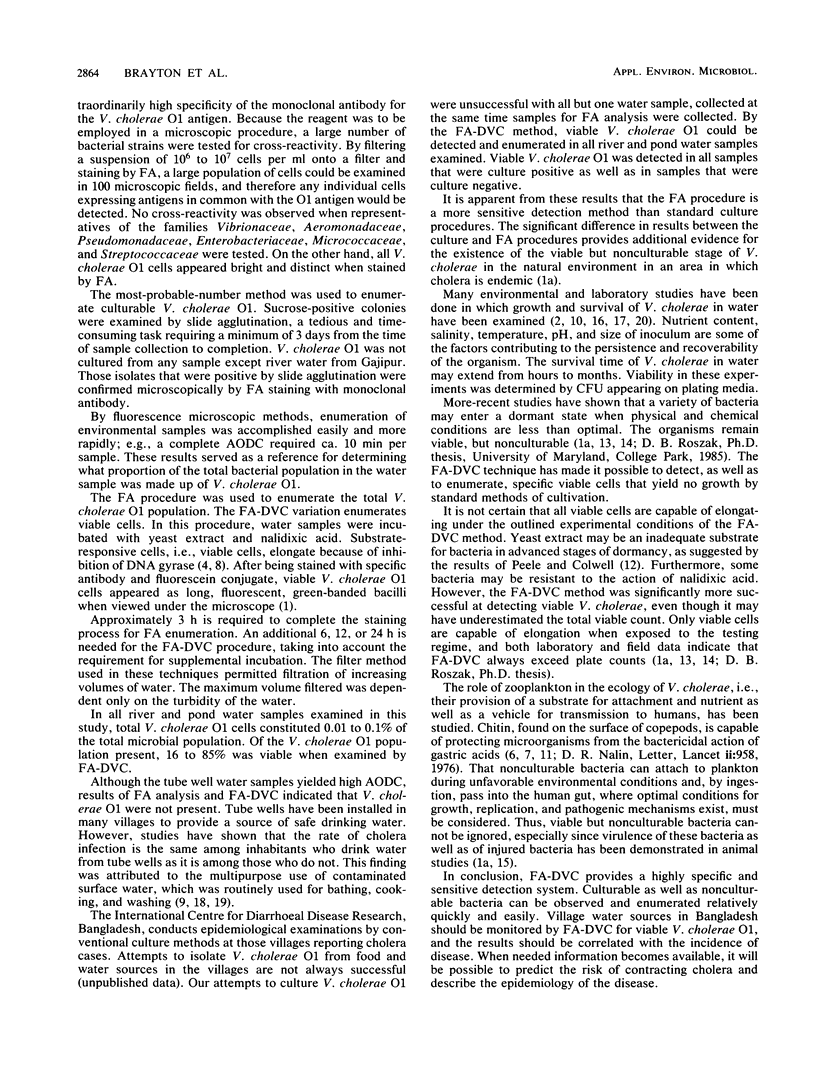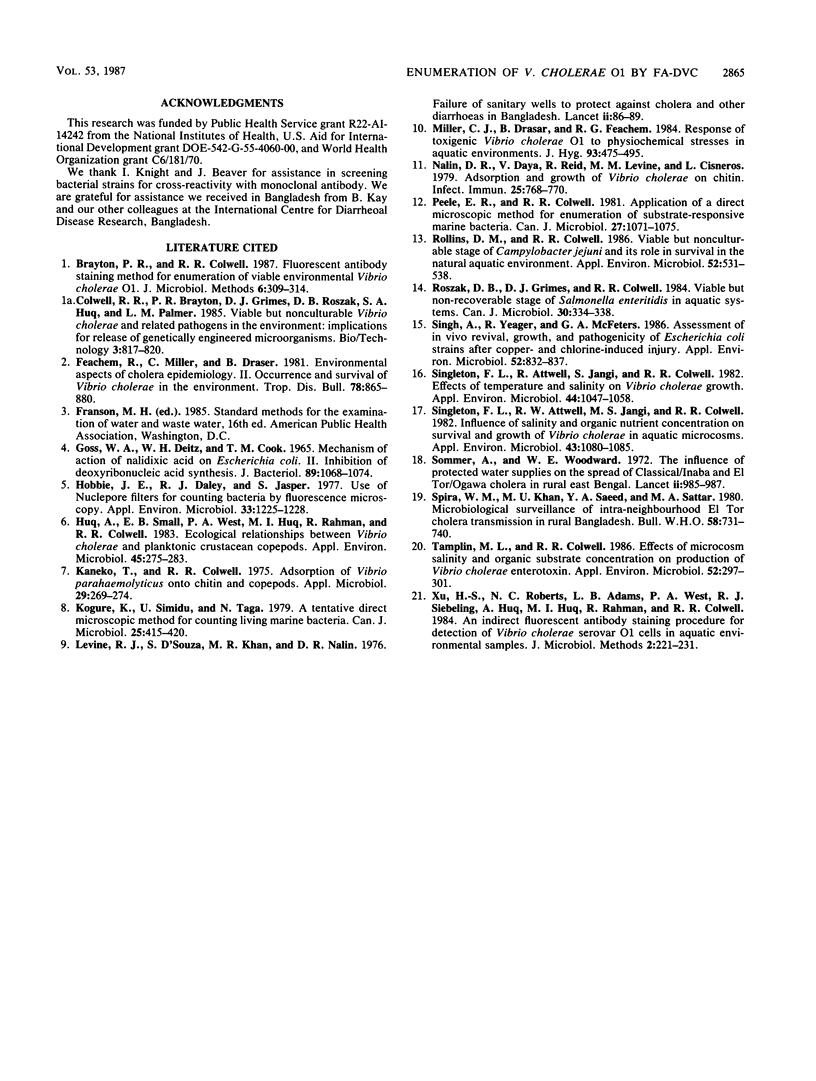Abstract
A field trial to enumerate Vibrio cholerae O1 in aquatic environments in Bangladesh was conducted, comparing fluorescent-antibody direct viable count with culture detection by the most-probable-number index. Specificity of a monoclonal antibody prepared against the O1 antigen was assessed and incorporated into the fluorescence staining method. All pond and water samples yielded higher counts of viable V. cholerae O1 by fluorescent-antibody direct viable count than by the most-probable-number index. Fluorescence microscopy is a more sensitive detection system than culture methods because it allows the enumeration of both culturable and nonculturable cells and therefore provides more precise monitoring of microbiological water quality.
Full text
PDF



Selected References
These references are in PubMed. This may not be the complete list of references from this article.
- Feachem R., Miller C., Drasar B. Environmental aspects of cholera epidemiology. II. Occurrence and survival of Vibrio cholerae in the environment. Trop Dis Bull. 1981 Oct;78(10):865–880. [PubMed] [Google Scholar]
- GOSS W. A., DEITZ W. H., COOK T. M. MECHANISM OF ACTION OF NALIDIXIC ACID ON ESCHERICHIA COLI.II. INHIBITION OF DEOXYRIBONUCLEIC ACID SYNTHESIS. J Bacteriol. 1965 Apr;89:1068–1074. doi: 10.1128/jb.89.4.1068-1074.1965. [DOI] [PMC free article] [PubMed] [Google Scholar]
- Hobbie J. E., Daley R. J., Jasper S. Use of nuclepore filters for counting bacteria by fluorescence microscopy. Appl Environ Microbiol. 1977 May;33(5):1225–1228. doi: 10.1128/aem.33.5.1225-1228.1977. [DOI] [PMC free article] [PubMed] [Google Scholar]
- Huq A., Small E. B., West P. A., Huq M. I., Rahman R., Colwell R. R. Ecological relationships between Vibrio cholerae and planktonic crustacean copepods. Appl Environ Microbiol. 1983 Jan;45(1):275–283. doi: 10.1128/aem.45.1.275-283.1983. [DOI] [PMC free article] [PubMed] [Google Scholar]
- Kaneko T., Colwell R. R. Adsorption of Vibrio parahaemolyticus onto chitin and copepods. Appl Microbiol. 1975 Feb;29(2):269–274. doi: 10.1128/am.29.2.269-274.1975. [DOI] [PMC free article] [PubMed] [Google Scholar]
- Kogure K., Simidu U., Taga N. A tentative direct microscopic method for counting living marine bacteria. Can J Microbiol. 1979 Mar;25(3):415–420. doi: 10.1139/m79-063. [DOI] [PubMed] [Google Scholar]
- Levine R. J., Khan M. R., D'Souza S., Nalin D. R. Failure of sanitary wells to protect against cholera and other diarrhoeas in Bangladesh. Lancet. 1976 Jul 10;2(7976):86–89. doi: 10.1016/s0140-6736(76)92299-6. [DOI] [PubMed] [Google Scholar]
- Miller C. J., Drasar B. S., Feachem R. G. Response of toxigenic Vibrio cholerae 01 to physico-chemical stresses in aquatic environments. J Hyg (Lond) 1984 Dec;93(3):475–495. doi: 10.1017/s0022172400065074. [DOI] [PMC free article] [PubMed] [Google Scholar]
- Nalin D. R., Daya V., Reid A., Levine M. M., Cisneros L. Adsorption and growth of Vibrio cholerae on chitin. Infect Immun. 1979 Aug;25(2):768–770. doi: 10.1128/iai.25.2.768-770.1979. [DOI] [PMC free article] [PubMed] [Google Scholar]
- Rollins D. M., Colwell R. R. Viable but nonculturable stage of Campylobacter jejuni and its role in survival in the natural aquatic environment. Appl Environ Microbiol. 1986 Sep;52(3):531–538. doi: 10.1128/aem.52.3.531-538.1986. [DOI] [PMC free article] [PubMed] [Google Scholar]
- Roszak D. B., Grimes D. J., Colwell R. R. Viable but nonrecoverable stage of Salmonella enteritidis in aquatic systems. Can J Microbiol. 1984 Mar;30(3):334–338. doi: 10.1139/m84-049. [DOI] [PubMed] [Google Scholar]
- Singh A., Yeager R., McFeters G. A. Assessment of in vivo revival, growth, and pathogenicity of Escherichia coli strains after copper- and chlorine-induced injury. Appl Environ Microbiol. 1986 Oct;52(4):832–837. doi: 10.1128/aem.52.4.832-837.1986. [DOI] [PMC free article] [PubMed] [Google Scholar]
- Singleton F. L., Attwell R. W., Jangi M. S., Colwell R. R. Influence of salinity and organic nutrient concentration on survival and growth of Vibrio cholerae in aquatic microcosms. Appl Environ Microbiol. 1982 May;43(5):1080–1085. doi: 10.1128/aem.43.5.1080-1085.1982. [DOI] [PMC free article] [PubMed] [Google Scholar]
- Singleton F. L., Attwell R., Jangi S., Colwell R. R. Effects of temperature and salinity on Vibrio cholerae growth. Appl Environ Microbiol. 1982 Nov;44(5):1047–1058. doi: 10.1128/aem.44.5.1047-1058.1982. [DOI] [PMC free article] [PubMed] [Google Scholar]
- Sommer A., Woodward W. E. The influence of protected water supplies on the spread of classical-Inaba and El Tor-Ogawa cholera in rural East Bengal. Lancet. 1972 Nov 11;2(7785):985–987. doi: 10.1016/s0140-6736(72)92401-4. [DOI] [PubMed] [Google Scholar]
- Spira W. M., Khan M. U., Saeed Y. A., Sattar M. A. Microbiological surveillance of intra-neighbourhood E1 Tor cholera transmission in rural Bangladesh. Bull World Health Organ. 1980;58(5):731–740. [PMC free article] [PubMed] [Google Scholar]
- Tamplin M. L., Colwell R. R. Effects of microcosm salinity and organic substrate concentration on production of Vibrio cholerae enterotoxin. Appl Environ Microbiol. 1986 Aug;52(2):297–301. doi: 10.1128/aem.52.2.297-301.1986. [DOI] [PMC free article] [PubMed] [Google Scholar]


